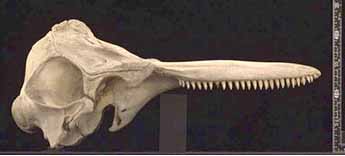 Autoceta: Whales & dolphins.
Autoceta: Whales & dolphins.| Cetartiodactyla | ||
| The Vertebrates | Autoceta |
| Vertebrates Home | Vertebrate | Vertebrate |
|
Abbreviated Dendrogram
Laurasiatheria
├─Ferae
└─┬─Perissodactyla
│
└─Cetartiodactyla
├─Cetacea
│ ├─Pakicetidae
│ └─Autoceta
│ ├─Odontoceti
│ │ ├─Squalodontoidea
│ │ │ ├─Squalodontidae
│ │ │ └─Rhabdosteidae
│ │ └─Physeteroidea
│ └─Mysticeti
└─Artiodactyla
├─Suina
│ ├─Hippopotamidae
│ └─Suoidea
└─Selenodontia
├─Camelidae
└─Ruminantia
├─Giraffoidea
└─┬─Bovoidea
└─Cervoidea
|
Contents
Overview |
 Autoceta: Whales & dolphins.
Autoceta: Whales & dolphins.
Basilosauridae :: Dorudon + * : Odontoceti + Mysticeti.
1-31 m, 20-160,000 kg [N91]; fusiform body [GU98] [N91]; body form minimizes drag [V+00] [1]; CRANIAL rostrum usually large, formed by prenarial premaxilla & maxilla [FB94]; external nares above and behind orbits [FB94], usually at highest point of head [N91]; nares attached directly to lungs (adaptation to allow suckling in water?) [N91]; premaxilla and maxilla form most of anterior and roof of skull, with reduction of nasals & parietals [V+00]; frontals large, but mostly covered by maxillae & premaxillae [V+00]; zygomatic process of squamosal contacts postorbital process of frontal (may be ligamentous contact); occipitals form back of skull [V+00]; orbits placed widely apart under long, flat, transversely broad supraorbital process [FB94]; eyes relatively small [FB94]; unique adaptations of eye for vision in air & water; relatively poor vision with out fine adjustment of lens shape or position [V+00]; temporalis muscles large [FB94]; robust basioccipital crests (= falcate process), with each bulla having thin outer lip [FB94]; external auditory meatus closed [FB94]; highly modified periotic or petrosal bones [GU98]; large tympanic cavity [FB94]; tympanic membrane absent; auditory bulla with middle & inner ear not braced against skull & may be insulated by air cavities; dense tympanic bullae [GU98]; bulla posterior process attached by single pedicle (reversal?) [L98$]; conical apophysis appressed against sigmoid process (reducing external auditory meatus to a fold) [L98]; sigmoid process with fused malleus [FB94]; sigmoid process usually articulating with tegmen tympani of petrosal [L98]; sigmoid process loses contact with squamosal [L98$]; anterior process (processus tubarius) loses contact with petrosal [L98$]; large stapedius muscle fossa [FB94]; smooth dorsal face on cochlear portion of periotic [FB94]; reduced foramina for internal carotid artery [FB94]; vomer exposed on basicranium, covering suture between basioccipital & basisphenoid; large mandibular canals with thin lateral acoustic fenestrae for sound reception [G98]; all living groups monophyodont [U98]; AXIAL vertebrae horizontally compressed, with tall neural spines [V+00]; lengthened "torso" (all lumbarized vertebrae) provide extensive area for attachment of musculature for axial undulation [B98]; extension of torso from increase in lumbar number, increased lumbar centrum length & lumbarization of posterior thoracics & anterior caudals [B98]; thoracic vertebra centrum length increase smoothly to tail [B98]; single peak in centrum length within torso (undulatory wave with variable amplitude) [B98]; ribs attached loosely to thoracic vertebrae & sternum [FB94]; often dorsal "fin" supported by connective tissue [FB94]; no obvious sacral vertebrae [FB94]; lumbar vertebrae with robust spines & transverse processes for massive tail muscles [FB94]; caudal vertebrae in 3 zones: lumbarized (extension of torso), narrow peduncle, & fluke [B98]; spherical "ball" vertebra at pedicle - fluke junction [FB94]; tail with broad, terminal horizontal fluke [GU98] [V+00]; APPENDICULAR clavicle absent [V+00]; scapula with reduced supraspinous fossa [FB94]; scapula with parallel, anteriorly directed acromion & coracoid processes [FB94]; humerus extremely robust & much shorter than ulna [U98]; forelimbs paddle-shaped, with short proximal segments and elongated digits (flipper) [GU98] [V+00]; hyperphalangy common [FB94]; no external digits or unguals [V+00]; pelvic girdle only for muscular attachment of muscles for external sexual organs [N91]; hindlimbs vestigial & not attached to vertebral column; nearly hairless [V+00]; OTHER numerous physiological adaptations for prolonged and deep diving; rapid swimmers; bone spongy & oil-filled [N91]; sebaceous glands absent [N91] [V+00]; numerous retia mirabilia [V+00]; 2+ times as many erythrocytes per volume as terrestrial mammals [V+00]; 2-9X myoglobin as terrestrial mammals [V+00]; blubber insulation [V+00]; blubber eliminates expression as means of communication [FB94]; 3-chambered stomach; male genitalia internal [V+00]; gestation 9.5-17 mo, with single births [N91]; neonates are highly precocial [N91]; single pair of mammae, flat against body wall & near urogenital opening [V+00]; completely aquatic [GU98]; during deep diving, lungs collapse, heart rate drops 50% & blood is shunted to critical organs [V+00]; sound communication important and complex [GU98]; ability to sense geomagnetic contours [V+00].
 |
||
| Sphere | Cylinder | |
| Max. Cross- sectional Area |
πR² | πr² |
| Surface Area | 4πR² | πr(r² + h²)½ + πr² |
| Volume | 4πR³/3 | πr²h/3 |
Notes: [1] drag is a function of cross-sectional area and total surface area. Muscle mass, and hence power, increases as a function of volume. Accordingly, other things being equal, muscle mass increases faster than drag. Thus larger forms are much faster. Large size also improves insulation problem in cold waters, since heat loss is a function of area and metabolic heat production is a function of volume.
Both of these advantages of large size are improved by being more nearly spherical than cylindrical. Whales could be more realistically described with a combination of these shapes, or by using an ellipsoid rather than a sphere. One very crude model is shown at right.
Image: (upper right) Tursiops from Mammalian Crania Picture Archive of the Department of Anatomy, Tokyo University School of Medicine.
Links: CETACEA; Wal und Mensch | Wale, Delphine, Menschen; Whale and Dolphin Information on the World-Wide-Web; Animal Diversity Web: Order Cetacea; Cétacés baleines, dauphins et marsouins); Cetaceans; Order Cetacea.
References: Buchholtz 1998) [B98]; Fordyce & Barnes (1994) [FB94]; Gingerich 1998) [G98]; Gingerich & Uhen (1998) [GU98]; Luo (1998) [L98]; Nowak 1991) [N91]; Uhen (1998) [U98]; Vaughn et al (2000) [V+00]. ATW030125.
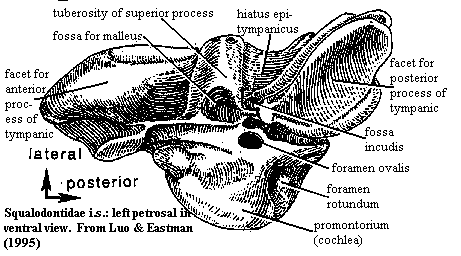 Odontoceti: dolphins, porpoises & toothed whales
Odontoceti: dolphins, porpoises & toothed whales
Range: from the Late Oligocene [FB94].
Phylogeny: Autoceta : Mysticeti + * : Squalodontoidea + Physeteroidea.
Characters: skulls asymmetrical; trend to increase face size [FB94]; posterior process of maxilla extends above orbit [FB94]; melon organ (or spermaceti organ in physeterids) present and especially well developed in forms hunting in deep seas or turbid waters [N91]; maxillary process forms origin for muscles to blowhole, probably for ultrasound production [FB94]; sense of smell vestigial [N91]; trend to shorten intertemporal region [FB94]; maxilla & frontal grow back over braincase [U98]; highly-developed echolocation [V+00]; sounds include clicks of 1-10 msec at 100-200 kHz, largely for echolocation, and whistles of up to 500 msec at 4-20 kHz, for communication [N91]; bullar accessory ossicle present (incorporated into adult bulla in other ungulates) [L98$]; Eustachian tube on bulla with spout-like sharp-edged margin [L98$]; petrosal lacks conventional epitympanic recess but has specific recesses for incus (fossa incudis) and malleus, as well as a smooth recess, the hiatus epitympanicus [LE95]; subarcuate fossa of petrosal absent [2] [LE95]; basilar membrane of cochlea supported between primary and secondary bony laminae [LE95]; basilar membrane of cochlea thin [LE95]; cochlea with few turns and wide separation between turns [LE95]; scala tympani much larger than scala media and scala vestibuli in cochlea basal turn [LE95]; semicircular canals very small [LE95]; basicranial sinuses present and trend to enlarge [FB94]; teeth present; single blow hole [V+00]; trend raise position of blow hole [FB94]; carnivorous; prey sucked in by retraction of tongue [V+00]; use of ultrasound to stun prey [V+00].
Note: [1] the execrable molecular folks have been at it again, this time claiming that the Odontoceti are paraphyletic and that Physeteroidea and Mysiceti form a clade. Believe them at your peril. [2] may be characteristic of a larger clade. [3] In the figure on the right, the facets for the "tympanic" refer to the ectotympanic bulla.
Links: Toothed whales - Enchanted Learning Software; Odontoceti (Zahnwale) German); OceanLink Answers to Odontoceti (toothed whale) Questions everything you were afraid to ask -- Best on the Web); Odontoceti Tree of Life); Zahnwale (Odontoceti) German); Suborden ODONTOCETI (Flower, 1867) Spanish); Odontoceti Mikko's Phylogeny); ???? Suborder Odontoceti Chinese); et@llcorp.
References: Fordyce & Barnes (1994) [FB94]; Luo (1998) [L98]; Luo & Eastman (1995) [LE95]; Nowak 1991) [N91]; Uhen (1998) [U98]; Vaughn et al (2000) [V+00]. ATW030125.
Range: Late Oligocene to Middle Miocene [LE95].
Phylogeny: Odontoceti : Physeteroidea + * : Squalodontidae + Rhabdosteidae.
Characters: "shark-like" teeth, with cheek teeth triangular and serrated.
Notes: may be paraphyletic stem group Odontoceti, or at least Delphinoidea. [LE95].
Image: both elements from Jayson Kowinsky's FossilGuy Web Page, with permission. As Jayson notes: "Notice the large pectoral fins, reduced dorsal fin, mobile neck, the long beak, and the front teeth protruding from the jaw, creating small "tusks." The body shape is based on an Irrawaddy Dolphin (Orcaella brevirostris), due to its large pectoral fins, mobile neck, and reduced dorsal fin. The head is based on many Squalodon skulls, the body pattern is similar to a Rough-Toothed Dolphin (Steno bredanensis)."
Links: Squalodontoidea Mikko's Phylogeny); @PHOCOENA.ORGPorpoise Evolution Emergence of Cetaceans Whales ...; Cetaceans.
References: Luo & Eastman (1995) [LE95]. ATW030111
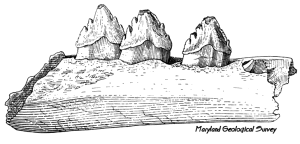 Squalodontidae: Patriocetus, Squalodon
Squalodontidae: Patriocetus, Squalodon
Range: Late Oligocene to Late Miocene [FB94]
Phylogeny: Squalodontoidea : Rhabdosteidae + *.
Characters: overall length about 5m; skull robust [DS00]; base of rostrum broad, but very narrow anteriorly [DS00]; maxilla makes up most of rostrum [DS00]; premaxillae very long, with posterior ends narrow & splint-like, terminating just posterior to nares [DS00]; maxillae overgrow parts of frontals [DS00]; most of skull roof from frontals [DS00]; zygomatic process of squamosal straight & long [DS00]; supraoccipital strongly concave & overgrows posterior parietals [DS00]; cochlea basilar membrane thicker than in modern 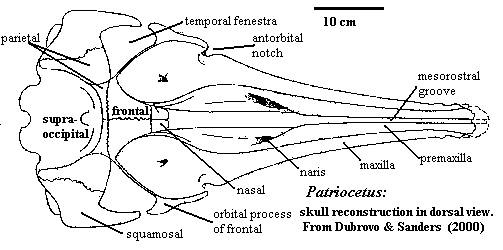 dolphin [LE95]; mesial teeth simple & conical; distal teeth complex & two-rooted; neck mobility intermediate (archaeocetes have mobile necks, autocetes immobile); cranium were well compressed, as in autocetes; melon organ probably present (echolocation).
dolphin [LE95]; mesial teeth simple & conical; distal teeth complex & two-rooted; neck mobility intermediate (archaeocetes have mobile necks, autocetes immobile); cranium were well compressed, as in autocetes; melon organ probably present (echolocation).
Note: this is a very poorly known group. The characters from [DS00] may only apply to Patriocetus.
Image: partial jaw & molars of Squalodon from Maryland Geological Survey: Miocene Fossil Teeth.
Links: Maryland Geological Survey- Miocene Sharks Teeth of Calvert ...; Jayson and Amy's Fossil Page (fossilguy.com) Best on the Web); mammals2; Cetaceans; Aquaheart2 Japanese); Origen y evolución de los cetáceos; Nouvelle page 3; Independent adaptation to riverine habitats allowed survival of ....
References: Dubrovo & Sanders (2000) [DS00]; Luo & Eastman (1995) [LE95]. ATW030111.
 Rhabdosteidae: f/k/a Eurhinodelphidae. Eurhinodelphis, Iniopsis
Rhabdosteidae: f/k/a Eurhinodelphidae. Eurhinodelphis, Iniopsis
Range: Early Miocene to Late Miocene
Phylogeny: Squalodontoidea : Squalodontidae + *.
Characters: skull small & symmetrical [FB94]; extremely elongated snout [FB94]; accessory ossicle articulates with anterior bullar facet [Z98]; complex teeth as for parent clade.
Links: Jayson and Amy's Fossil Page (fossilguy.com); ?????????? Chinese); Cetaceans.
References: Fordyce & Barnes (1994) [FB94]; Luo 1998) [L98]. ATW030111
 Physeteroidea: sperm whales. Physeter, Kogia
Physeteroidea: sperm whales. Physeter, Kogia
Range: from the Early Miocene [V+00] [N91] or Late Oligocene [FB94] (both very emphatic about it, too!). First found in South America. Presently cosmopolitan. [N91].
Phylogeny: Odontoceti : Squalodontoidea + *.
Characters: broad, flat rostrum [N91]; "facial" skull deeply depressed to accommodate spermaceti organ [N91]; melon organ primitively present? [FB94]; melon functionally replaced by spermaceti organ? [N91]; S-shaped blowhole on left side of snout [N91]; simple air sinus system with left passage for respiration & right for sound production [N91]; accessory ossicle of bulla fuses with anterior process of petrosal [L98]; trend to lose upper teeth [FB94]; lower jaw narrow & much shorter than rostrum [N91]; throat with numerous short grooves in skin [N91]; pectoral limbs small [N91].
Links: Pottwalartige (Physeteroidea) German); Physeteroidea Mikko's Phylogeny).
References: Fordyce & Barnes (1994) [FB94]; Luo (1998) [L98]; Nowak 1991) [N91]; Vaughn et al (2000) [V+00]. ATW030112.
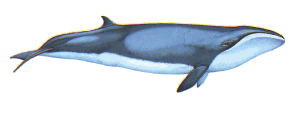 Mysticeti: baleen whales, including blue whales, humpback whales, gray whales and right whales. Eubalaena, Megaptera
Mysticeti: baleen whales, including blue whales, humpback whales, gray whales and right whales. Eubalaena, Megaptera
Range: from the Middle Eocene? [V+00] Late Oligocene [FB94]?
Phylogeny: Autoceta : Odontoceti + *.
 Characters: trend to large size [FB94]; skulls symmetrical; intertemporal region short [FB94]; sense of smell absent [N91]; maxilla extends under orbit to form infraorbital process [FB94]; occipital grows forward over braincase [U98]; auditory bullae relatively small [G98]; bulla with median ridge, rather than furrow [L98]; bulla posterior process fused with posterior process of petrosal [L98]; echolocation absent; keratinous baleen) plates in place of teeth for filter feeding; baleen attached to maxilla [FB94]; baleen smooth externally, frayed internally [N91]; neck short [FB94]; two blow holes; filter either by straining directly, or by swallowing water or sediment and straining outward [V+00]; living species all large filter feeders [FB94].
Characters: trend to large size [FB94]; skulls symmetrical; intertemporal region short [FB94]; sense of smell absent [N91]; maxilla extends under orbit to form infraorbital process [FB94]; occipital grows forward over braincase [U98]; auditory bullae relatively small [G98]; bulla with median ridge, rather than furrow [L98]; bulla posterior process fused with posterior process of petrosal [L98]; echolocation absent; keratinous baleen) plates in place of teeth for filter feeding; baleen attached to maxilla [FB94]; baleen smooth externally, frayed internally [N91]; neck short [FB94]; two blow holes; filter either by straining directly, or by swallowing water or sediment and straining outward [V+00]; living species all large filter feeders [FB94].
Links: Baleen whales - Enchanted Learning Software; Mysticeti (Bartenwale) German); Mysticeti Tree of Life); OceanLink Answers to Mysticeti (Baleen Whale) Questions; Mysticeti indet.; Bartenwale (Mysticeti); Mysticeti Mikko's Phylogeny); Bartenwale oder Mysticeti; Kosticovci - Mysticeti; Galerie - Savci.upol.cz; ???? Suborder Mysticeti; BALEEN WHALES; Baleen Whales- Scientific Classification.
References: Fordyce & Barnes (1994) [FB94]; Gingerich 1998) [G98]; Luo (1998) [L98]; Nowak (1991) [N91]; Uhen (1998) [U98]; Vaughn et al (2000) [V+00]. ATW030125.
checked ATW051030